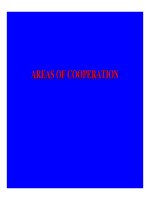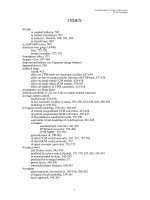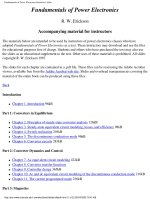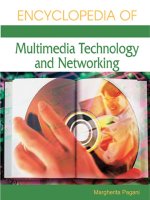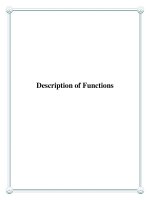Tài liệu ASSESSMENT OF ANAEROBIC TREATMENT OF SELECT WASTE STREAMS IN PAPER MANUFACTURING OPERATIONS pot
Bạn đang xem bản rút gọn của tài liệu. Xem và tải ngay bản đầy đủ của tài liệu tại đây (1.16 MB, 113 trang )
ASSESSMENT OF ANAEROBIC TREATMENT OF SELECT WASTE
STREAMS IN PAPER MANUFACTURING OPERATIONS
A Thesis
Presented to
The Academic Faculty
By
Nadia Szeinbaum
In Partial Fulfillment
Of the Requirements for the Degree
Master of Science in the
School of Civil and Environmental Engineering
Georgia Institute of Technology
May 2009
ASSESSMENT OF ANAEROBIC TREATMENT OF SELECT WASTE
STREAMS IN PAPER MANUFACTURING OPERATIONS
Approved by:
Dr. Spyros G. Pavlostathis, Advisor
School of Civil and Environmental Engineering
Georgia Institute of Technology
Dr. Sujit Banerjee
School of Chemical and Biomolecular Engineering
Institute of Paper Science and Technology
Georgia Institute of Technology
Dr. Madan Tandukar
School of Civil and Environmental Engineering
Georgia Institute of Technology
Date Approved: May 15
th
, 2009
I dedicate this Thesis to
my father, Mario Szeinbaum,
for being a constant source of inspiration
in the effort of always giving the best of oneself.
iv
ACKNOWLEDGEMENTS
I am very thankful for having completed this thesis under the guidance of Dr. Spyros G.
Pavlostathis. He not only encouraged me during the completion of this work, and taught
me, through his example, what it means to be a researcher and to be a professional, but
was also always very supportive in all aspects of my academic experience.
I am also very thankful to the committee members, Dr. Sujit Banerjee and Dr. Madan
Tandukar, for their time devoted to reviewing the thesis, and their suggestions, which
improved my work.
I am truly thankful to having Malek Hajaya, Ulas Tezel, Teresa Misiti, Soon-Oh Hong,
and Samuel Huber working beside me. I couldn’t have completed this thesis without all
their help, in all aspects. In this respect, I also want to thank Zohre Kurt and Emmie
Granbery for being always there for me.
Family and friends, although in another hemisphere of the world, for being always very
close to me. This thesis has meaning for me, because of them.
Finally, this scholarly fulfilment could not have been achieved without the financial
support of Kimberly Clark Corporation. I want to thank, particularly, Juan Ernesto
Debedout and Jean Carlo Tellini, for their support and commitment to the project, as well
as to Manuel Sibaja, Yunier Campos, Noiry Madrigal, Susan Alfaro, and all other
members of the Kimberly Clark team, for all their help.
v
TABLE OF CONTENTS
SUMMARY XII
CHAPTER 1 1
INTRODUCTION 1
CHAPTER 2 3
BACKGROUND 3
2.1 Paper Mill Waste Generation and Management 3
2.1.1 Paper Mill Waste Origin and Composition 3
2.2 Treatment of Paper Mill Wastes 7
2.2.1 Treatment Options of Wastewater 7
2.2.2 Drawbacks Associated with the Current Solid Waste Management System 9
2.3 Alternative Treatment Option: Anaerobic Digestion of Paper Mill Wastes 11
2.3.1 Methane Generation in Anaerobic Digestion of Industrial Wastes 11
2.3.3 Generation of Methane and its Value 12
2.3.2 Potential for the Anaerobic Digestion of Paper Mill Wastes 13
2.3.4 Biochemical Principles of Anaerobic Digestion 15
2.3.6 Feasibility of Anaerobic Digestion of Paper Mill Sludges 18
CHAPTER 3 20
SYSTEM OF STUDY 20
3.1 Waste Generation During Paper Manufacturing Operations 20
3.2 Waste Generation During Wastewater Treatment Operations 22
3.3 Proposed Changes to the System 23
vi
3.4 Experimental Approach 24
3.4.1 Phases of Study 24
CHAPTER 4 27
MATERIALS AND ANALYTICAL METHODS 27
4.1 Analyses at the Paper Mill Laboratory 27
4.1.1 Total Suspended Solids (TSS) 27
4.1.2 Volatile Suspended Solids (VSS) 27
4.1.3 Total and Soluble Chemical Oxygen Demand (COD) 28
4.1.4 Inorganic Ions 28
4.1.5 pH 30
4.2 Analyses at the Georgia Institute of Technology, Atlanta, Georgia 30
4.2.1 pH 30
4.2.2 Total and Volatile Solids (TS and VS) 31
4.2.3 Total and Volatile Suspended Solids 31
4.2.4 Gas Production and composition 33
4.2.5 Volatile Fatty Acids (VFAs) 34
4.2.6 Organic Acids 34
4.2.6 Ions 35
4.2.7 Ammonia 35
4.2.8 Methanogenic culture and media 36
CHAPTER 5 38
PLANT VARIABILITY AND SAMPLE CHARACTERIZATION 38
5.1 Introduction 38
vii
5.2 Sample characterization 38
5.2.1 Plant variability 38
5.3 Materials and Methods 42
5.3.1 Characterization at the Paper Mill 42
5.3.2 Characterization of Select Samples for Laboratory Studies 42
5.4 Results and Discussion 43
5.4.1 Characterization at the Paper Milla 43
5.4.2 Characterization of Select Samples for Laboratory Studies 47
CHAPTER 6 50
BATCH ANAEROBIC BIODEGRADABILITY ASSAYS 50
6.1 Introduction 50
6.2 Materials and Methods 50
6.2.1 Samples 50
6.2.2 Methanogenic Culture 51
6.2.3 Ultimate Biodegradability Assays 51
6.3.1 Ultimate Biodegradability of Single Waste Streams (Assay I) 56
6.3.2 Ultimate Biodegradability of Combined Waste Samples (Assay II) 68
6.3.2.3 Process Rates of Combined Waste Samples 73
SEMICONTINUOUS FLOW REACTORS FOR ANAEROBIC DIGESTION 75
7.1 Introduction 75
7.2.1 Experimental Setup 76
7.3 Results and Discussion 80
7.3.1 Flotation Cell Skimmings and Mill DAF Skimmings Combination (Feed 1) . 80
viii
7.3.2 WWTP DAF Skimmings and WAS Combination (Feed 2) 84
7.3.3 Feed 1 vs. Feed 2 89
CHAPTER 8 91
CONCLUSIONS AND RECOMMENDATIONS 91
REFERENCES 97
ix
LIST OF TABLES
Table 4.1. Composition of media for the mixed anaerobic culture used in this study 37
Table 5.1. Monitoring points at the study paper mill 40
Table 5.2. Sample origin at the study paper mill 40
Table 5.3. Waste streams variation at the study paper mill (July 2008)–TSS, VSS, pH,
and COD (mean ± standard deviation; n = 6) 45
Table 5.4. Waste streams variation at the study paper mill (July 2008)–Nutrients (mean ±
standard deviation; n = 6) 45
Table 5.5. Sample characterization – pH and COD 48
Table 5.6. Sample characterization – Solids and VFAs 48
Table 5.7. Sample characterization – Anions. 49
Table 6.1. Experimental Setup for All Batch Assays. 53
Table 6.2. Details of Batch Assay I Setup
a
55
Table 6.3. Details of Batch Assay II Setup 56
Table 6.4. Results for ultimate biodegradability of samples 1 to 4 (Assay I; seed blank
corrected). ……………………………………………………………………………….57
Table 6.5. Results for ultimate biodegradability of samples 1 to 4 (Assay I; seed blank
corrected)……………………………………………………………………………… 58
Table 6.6. Rate constants for anaerobic degradation of cellulosic material (Literature
data) 68
Table 6.7. Results for ultimate biodegradability of combined waste samples (Assay II). 69
Table 7.1. Start up conditions of the semicontinuous flow reactors used in this study. 77
Table 7.2. Operational conditions of the semicontinuous flow reactors used in this study.
77
Table7.3. Reactors’ performance during the stable operation period (Reactor 1 and 3;
Feed 1). 83
x
Table7.4. Reactors’ performance during the stable operation period (Reactors 2 and 4;
Feed 2). 88
xi
LIST OF FIGURES
Figure2.1. Methane price vs. time in the U.S.A (DOE 2008) 13
Figure 2.2. Simplified scheme of the biochemical steps that lead to methanogenesis from
complex organic material. 17
Figure 3.1. Natural and white finished tissue rolls. 21
Figure 3.2. Paper making manufacturing and wastewater treatment simplified scheme. 21
Figure 5.1. Simplified scheme of the manufacturing and wastewater treatment plant at the
study paper mill (Summer 2008). 41
Figure 5.2. Waste stream variation at the study paper mill ……………………………. 46
Figure 6.1. Gas production and composition of samples 1 through 8 ……………63
Figure 6.2. COD consumption over time for samples 1 through 8 (Assay I)…… ….67
Figure 6.3. Gas production and composition of combined waste samples (Assay II)… 72
Figure 6.4. COD consumption over time for combined waste samples. Error! Bookmark
not defined.
Figure 7.1. Semicontinuous flow reactors used in this study 76
Figure 7.2. Total gas production (A), nutrients and pH (B & C) of reactors operated with
Feed 1. 82
Figure 7.3. Total gas production (A), nutrients and pH (B & C) of reactors operated with
Feed 2. 87
xii
SUMMARY
The most common strategy for handling paper mill solid waste is typically disposal in
landfills. Several drawbacks, however, are associated with this type of solid waste
management, such as increasing costs due to oil price rise, governmental restrictions on
land use, and environmental concerns such as leaching of disposed contaminants into
groundwater, as well as methane generation of and release to the atmosphere, which
contributes to global warming. An alternative to reduce solids prior to disposal and to
recover methane as a renewable fuel is anaerobic digestion, but it is not yet clear whether
such an approach is feasible in paper mills.
In this study, the anaerobic digestion of paper mill waste streams was evaluated for a
paper plant located in Central America, to assess to what extent certain waste streams can
be anaerobically digested, to what extent energy can be produced in the form of methane
for implementation in a wastewater treatment plant, and to evaluate the conditions that
will favor methane generation from select waste streams.
Batch assays were performed to evaluate the biodegradability of single and combined
waste samples under ideal, laboratory conditions. Samples were obtained from the
manufacturing plant as well as the wastewater treatment plant at the paper mill under
study. The ultimate biodegradability ranged 25 to 85% in terms of volatile solids
destruction, corresponding to the waste activated sludge (WAS) and Flotation Cell
rejects, respectively. The chemical oxygen demand (COD) destruction of single samples
ranged from 45 to 63%, corresponding to WAS and wastewater treatment plant (WWTP)
xiii
dissolved air flotation (DAF) skimmings, respectively. Methane generation ranged from
80 to 190 ml at 35
o
C/g COD added for all single samples (excluding underflows). In
combination Feed 1 was reduced by 46 and 52% and Feed 2 by 27 and 38%, respectively.
Two combinations of two single samples each (Feed 1 and 2), formulated according to
plant operational data and the results obtained in the batch assays in terms of their solids
and COD destruction , were evaluated at different solids retention times (30, 20, 15, and
7 days) in semicontinuous flow anaerobic digesters. Nutrients (N, and P) availability as
well as alkalinity in the plant waste streams were evaluated and minimum supplements
were used to support an efficient anaerobic digestion process. The reactors reached stable
operation at all retention times evaluated. Methanogenesis was the predominant, terminal
metabolic process under anaerobic, mesophilic conditions, but the overall process rate
was determined by the hydrolysis of the particulate substrate. Reactors fed with Feed 1
achieved the highest level of destruction, which amounted to 85% of the biodegradable
portion of volatile solids at a solids retention time of 20 days. The methane yield varied
from 94 to 120 ml of methane at 35
o
C per gram COD consumed. Nutrient (N and P)
availability had the largest impact on the performance of the reactors, given the very
limited amount of nitrogen and phosphorus that is typically present in paper mill wastes.
Alkalinity addition to the feed (3.5 mg NaHCO
3
/L) was necessary to maintain the
reactors pH above 6.9.
The results of this study demonstrate that anaerobic digestion of select paper mill waste
streams is a feasible alternative leading to a decrease of landfill disposal of solid wastes,
as well as the production of energy in the form of methane, and sets the basis for further
evaluation of the full potential of this process in paper mills, especially in Latin America.
1
CHAPTER 1
INTRODUCTION
Papermaking is known to be a water intensive process. To reduce water consumption,
water recycling is employed, where a portion of the fibers are also reclaimed (de Alda
2008). Even though wastewater generation is greatly reduced, the resulting wastewater
has high COD values and solids, which are typically mechanically separated before the
wastewater enters the secondary treatment units. The resulting primary sludge is disposed
of in landfills, together with secondary sludge from the biological treatment. Paper mill
primary sludge contains wood fibers as the principal organic component, and inorganic
materials such as kaolin, CaCO
3
, TiO
2
, etc., that are used as paper fillers (de Alda 2008).
As landfill costs are rising because of regulations, space becoming more expensive and
transportation costs rise, alternatives to current waste solids disposal management are
needed. An alternative method of reducing solids is anaerobic digestion, where a mixed
culture of fermentative and methanogenic microorganisms utilize this waste as their
carbon and energy source. Not only the volume of solids can be reduced, but as methane
is released in the process and can be utilized (e.g., for steam and/or electricity
production), anaerobic digestion has the potential to add value to the waste.
In the papermaking industry the process variability, the type of paper produced, and the
primary products used is so large that different paper mills may discharge effluents with
significantly different composition (de Alda 2008; Kumar et al. 2008). It is therefore
important to rationally design a treatment process that specifically targets the
2
characteristics of a specific paper plant, in order to apply appropriate technology and
proper disposal of wastes.
In this study, the anaerobic digestion of paper mill waste steams was evaluated in a plant
located in Central America, with the objective of determining the feasibility of this type
of treatment method to reduce solids prior to disposal and generate methane. This plant
produces tissue paper products using only post-consumer recycled fibers, and is one of
many Latin American and Caribbean plants that currently operate in this mode. Such
plants could potentially implement the proposed technology.
The specific objectives of this study were:
1) To investigate whether certain waste streams can be anaerobically digested to
reduce the amount of solids to dispose of and which ones can be potentially
implemented.
2) To assess the potential solids reduction and energy production in the form of
methane for implementation in a wastewater treatment plant.
3) To evaluate the conditions which favor methane generation from select paper mill
waste streams.
3
CHAPTER 2
BACKGROUND
2.1 Paper Mill Waste Generation and Management
2.1.1 Paper Mill Waste Origin and Composition
Fibers for paper production (pulp) can be obtained from wood, agricultural crops such
flax, rice and wheat straw, as well as from recovered paper. During the production of
paper products, solid wastes (sludge) are generated, which can be of different origin: the
wastepaper coming from the production of virgin wood fiber, the wastepaper produced
by removing ink from post-consumer fiber (de-inking paper sludge), or the activated
sludge from the secondary treatment systems (secondary sludge) (Beauchamp et al.
2002).
Traditionally, wastes from the paper industry contained residues from both pulping and
paper making processes. Originally, paper products were obtained from virgin pulp by
mechanically and/or chemically separating it from the rest of the plant materials. In the
last decades, however, due to the increased consumption of paper products and the
increasing awareness of the environmental impact of pulping, many mills have included
secondary pulp (from recycled paper products) in their final products. The percentage of
plants including some proportion of recycled fibers has now reached a recent value of at
least 78% of the existing mills in America, as of 2005 (Huang and Logan 2008) . Some
4
paper mills, such as the system considered in the present study, employ 100% of
recovered paper in their products.
Since many paper mills rely on reusing paper, the pulp industry and the paper industry
are sometimes separate industries, and the processes and chemicals used in the pulping
and the papermaking operations are very different. As a result, wastewater from the
papermaking and de-inking process also differs significantly (Thompson et al. 2001).
Therefore, considering that waste composition and characteristics have changed, it is
important to review the current treatment alternatives employed and reconsider those that
have been overlooked because they were not suitable in the past. The composition of the
waste paper is the principal parameter that needs to be considered, although this is not
easy to determine, as a variety of industries provide post-consumer paper to reuse in a
mill, ranging from office waste paper to waste packaging paper. This results in the
generation of an undetermined mixture of wastes. However, recyclable paper does have
general characteristics that allow it to be reused. A brief description of what is expected
to be found in the wastes of a typical paper mill is provided below along with the
potential implications to the waste treatment process and their discharge into the
environment.
Cellulose and Hemicellulose. Cellulose fines and other additives can be up to 50% of the
total mass of the whitewaters produced. Cellulose is composed of building units called
cellobiose, two glucose molecules joined by a β-1,4 glycosidic bond (Bayer et al. 1998).
Complete hydrolysis of cellulose yields glucose, an easily biodegradable carbon source.
This component can contribute to an excessive BOD load in receiving water bodies as
part of the untreated paper mill effluent (highly charged whitewaters), but when a
5
secondary treatment is employed, cellulose can be mineralized. Hemicelluloses are
relatively low-molecular weight, branched heteropolysaccharides associated with both
cellulose and lignin and together build the plant cell wall material (Bayer et al. 2006).
Apart from cellulose and hemicellulose, additives are used during the papermaking
process. A variety of chemicals will confer different properties on the paper sheet, such
as sizing agents, fillers to improve the scattering coefficient (opacity) and reduce ink
absorbency, such as clays and other minerals, or color and other aesthetic properties,
modified with dyes. Also, since all wood cellulose fibers get negatively charged when
they are extracted from the primary substrate, as many additives also do, the addition of
cations such as aluminium, in the form of Al
2
(SO
4
)
3
, is employed to promote bridging
between fibers, thus improving the retention of fines. Addition of these chemicals not
only increases the amount of organic/inorganic solids that need to be treated, but when
employing secondary treatment, they may be toxic to the biota and therefore decrease the
efficiency of the treatment processes (Walker 2006). Chemicals typically used in
papermaking are described below:
Biocides. These chemicals are added to protect machinery and paper produced from
microbial growth, which is frequently a problem. This occurs because the process deals
with a high concentration of easily biodegradable substances such as hemicelluloses,
particularly when water is recirculated to reduce water consumption, and is also
facilitated by the high operation temperature during paper manufacturing. Wide range
spectrum biocides are typically used, which may also affect the viability of necessary
microorganisms such as those in the secondary wastewater treatment units, or affect biota
in the receiving water bodies if not biodegraded. Typically, biocides consist of oxidizing
6
agents (hydrogen peroxide), or organic chemicals (e.g., organo-thiocyanates, organo-
bromo compounds).
Surfactants. These chemicals are typically added to avoid biofilm formation as well as
cleaning agents, antifoamers, deinkers, dispersants, and for other purposes. These
chemicals are also detrimental to secondary wastewater treatment microbiota, as well as
having environmental toxic impacts on natural macrobiota. Typical surfactants include
alkylbenzene sulfonates and alkylphenol ethoxylates.
Fillers. Fillers include inorganics such as clay, calcium carbonate, as well as color
pigments. These additives are mostly the inorganic constituents of waste.
Adhesives. Usually, only post-consumer paper with very low percentage of adhesives
(around 2% w/w) is selected for recycling. However, as a result of water reuse, these
organics may accumulate over time.
Inks. Inks are a component of recycled paper. Therefore, as the proportion of recycled
paper increases, so does the amount of inks present in the manufacturing system.
However, the final product needs to be free of ink, and therefore de-inking is an
important, although complex, step. Washing and flotation processes are used to remove
printing inks, and are employed in the plant considered by the present study. Historically,
inks were hazardous to the environment, but their heavy metal content is now reduced to
acceptable limits (Jacob et al. 2005).
Regarding the environmental impact of wastes from paper mills, not having the pulping
process may be considered an advantage for these manufacturing plants, as the amount of
potentially toxic chemicals that need to be treated is significantly less, which alleviates
the need for advanced treatment and the potential for secondary treatment upsets due to
7
the presence of toxic substances. For example, in recycled paper effluents, the amount of
lignin, which is toxic to the methanogens is very low (Yin 2000). Also, importantly, the
amount of wood extractives (sterols, lignans) is expected to be very low. These chemicals
are released during the pulping processes to obtain cellulose from biomass and, when
dissolved in water, may result in toxicity in the secondary wastewater treatment or in the
receiving water bodies (Lacorte et al. 2003). Given that wood-free waste paper is used for
tissue production, wood extractives are unlikely to be a problem in tissue production.
To sum up, the portion and quality of fibers and additives depend on the type of paper
that is produced, and are as varied as the existent classes of paper. Given that a plant may
obtain their fiber from reclaimed paper of different sources, the exact chemical
composition of the paper mill waste streams is usually unknown, and probably unique, or
significantly different from that of another paper mill (Kumar et al. 2008; Kuokkanen et
al. 2008; Latorre et al. 2007). As a result, different levels and strength of organic wastes
are generated and need to be treated, or potential toxicity in the secondary wastewater
treatment may vary considerably. Therefore, although some general characteristics can be
assumed, the treatment options and conditions are expected to need to be tailored to a
particular scheme of production.
2.2 Treatment of Paper Mill Wastes
2.2.1 Treatment Options of Wastewater
8
The papermaking industry is one of the largest water users and generates large quantities
of highly polluted wastewater. In the last decades, the organic loading in paper mill
waters has increased. Because of environmental and legislative pressure as well as by
technological advances, water reuse has become a common procedure to reduce water
consumption which has been reduced by 80-90% (Asghar et al. 2008; Lerner et al. 2007;
Thompson et al. 2001). With each recycling cycle, the fibers in the paper become shorter
and the acceptable use is more restricted. As a result, a normal cycle produces white bond
paper, then colored bond paper, newspaper, grocery bags, and finally toilet paper. The
reuse of water not only causes several problems in the manufacturing operations, such as
build up of slime (undesired growth of microorganisms), but also, most importantly,
white waters get highly charged with organic matter as well as inorganic paper
constituents (Ali and Sreekrishnan 2001; Lacorte et al. 2003; Lerner et al. 2007;
Thompson et al. 2001).
Many paper mills treat their wastewaters by a primary treatment, followed by some form
of secondary treatment (Atkinson et al. 1997; Latorre et al. 2007; Thompson et al. 2001).
Since the wastewater is high in solids and COD, a primary treatment is needed to separate
the solids from deinking, recycling of whitewaters, or from the waste activated sludge.
Solids separation may be done by sedimentation or flotation in order to remove cellulosic
fibers, lignin and sand from the effluent (Rittmann and McCarty 2001; Stoica et al.
2009; Thompson et al. 2001). The solids are further dewatered and typically disposed of
in landfills or incinerated (Beauchamp et al. 2002; Zule et al. 2007). Solids incineration is
usually not the preferred alternative because, even upon dewatering, these wastes have
high water content, of at least 50% (Stoica et al. 2009).
9
Secondary wastewater treatment typically involves an aerobic activated sludge step,
followed by clarification and release of the effluent to a water body. Other treatment
options, such as membrane filtration are available, but usually costs associated with these
technologies limit their application (Thompson et al. 2001). Anaerobic treatment,
although common for agricultural and municipal wastes, is not common in the pulp and
paper industry (Thompson et al. 2001).However, it is noteworthy that as paper waste
composition is changing over time, the application of anaerobic treatment of wastewaters
or anaerobic digestion of solids might become a more common, and sustainable
alternative.
2.2.2 Drawbacks Associated with the Current Solid Waste Management System
2.2.2.1 Disposal Costs
In order to dispose of the solids generated in the papermaking and the wastewater
treatment processes, solids are pressed or centrifuged to reduce the amount of water, and
then transported by truck to their final destination in which they are disposed. Transport
and disposal account for a large portion of the total waste treatment costs (around 75% in
the system considered in this study). This is partly because, even after flotation and
drying, solids still have a high water content (Levy and Taylor 2003; Thompson et al.
2001). Considering that oil price is increasing over time (DOE 2008), and that regulations
on carbon emissions and land use are getting more stringent, it is foreseen that disposal
costs will inevitably rise (Levy and Taylor 2003). Furthermore, if it is taken into account
10
that biomass is a potential source of energy as methane (or biogas), which can be
generated by anaerobic digestion, not utilizing it as such can be considered as a cost to
the industry that generates it.
2.2.2.2 Environmental Impact of Solid Waste Disposal
Methane is produced in landfills because anaerobic conditions are created as waste is
disposed of with the appropriate amount of moisture content. Municipal waste landfills
are the largest anthropogenic source of methane in the U.S.A., accounting for 34% of all
methane emissions (Kumar et al. 2004). Methane is 23 times more potent than carbon
dioxide as a greenhouse gas, and under normal conditions, being lighter than air, it is lost
into the atmosphere (DOE 2004). Therefore, the uncontrolled release of methane from
landfills is an important environmental problem. The possibility of engineering a system
to obtain methane from solid wastes not only reduces the environmental impact of the
uncontrolled release of a potent greenhouse gas, but also makes the solid wastes a
significant renewable energy resource.
2.2.2.2 Additional Requirements of the Aerobic Secondary Treatment of Paper Mill
Wastes
Because of the nature of the wastes (high in carbon content but very low in nitrogen and
phosphorus), nutrients need to be supplemented. This is a concern not only because the
right dose needs to be achieved in order to obtain a stable system without leaving these
nutrients in the final, treated effluent, but also because nutrient addition increases the
treatment cost. Also, the system is highly dependent on the well functioning of aerators,
which consume large amounts of energy. Furthermore, when the plant is in continuous
11
operation, it is difficult to clean or repair when it is needed, and climatic conditions of
usually high temperature (around 30˚C) in Central America make this a common
problem. Also, maintaining a proper control of the dissolved oxygen (DO) concentration
in the aeration tank and maintaining a good settling sludge are not easy. Settling of
activated sludge treating paper mill wastewaters seems to be particularly prone to being
very variable as filamentous bacteria dominate in these reactors, and often create
conditions of bulking in the clarifier (Thompson et al. 2001).
2.3 Alternative Treatment Option: Anaerobic Digestion of Paper Mill Wastes
2.3.1 Methane Generation in Anaerobic Digestion of Industrial Wastes
The anaerobic treatment of wastes has many potential benefits, and several industries
have widely adopted this type of treatment. Many municipal wastewater sludges and
solid wastes in the U.S. are being treated this way, and the process has been found to be
fairly reliable (Rittmann and McCarty 2001). In agricultural systems, anaerobic digestion
has been successfully applied. In many cases, biogas is used to generate electric power,
with many of the farms recovering waste heat from the electricity generating equipment
for on-farm use (generating about 244,000 MWh of electricity per year in a typical US
farm) or use of the gas in boilers, for example. As of February 2009, the combustion of
biogas from agricultural digesters prevented the emission of about 36,000 metric tons of
methane annually, plus the amount of greenhouse gases saved from the use of fossil fuels,
in the US (EPA 2009).
12
2.3.3 Generation of Methane and its Value
Methane generation from biomass has its inherent value. As opposed to the
mineralization of the organic matter to CO
2
that results from an aerobic treatment, which
is subsequently released into the atmosphere and contributes to the overall pool of
greenhouse gases, in the anaerobic treatment of organic solids, methane is generated,
which can be collected and utilized as a fuel. Therefore, even though the final product
will be CO
2,
the biomass is not completely unutilized.
Methane yields 890 KJ/mol or 380,000 BTU/m
3
when burned with oxygen (Insam and
Wett 2008). Methane is flammable at a ratio of 5-12% of CH
4
in air, so with typical,
expected biogas content of around 50% of methane, anaerobic digestion of wastes is a
good alternative to generate useful biogas. Furthermore, when employing waste biomass,
the generation of methane is considered a renewable source of fuel production, which
adds value to the waste, as opposed to viewing it as a cost. Also, in terms of safety, since
the gas density relative to air is 0.55, in case of leaks it will migrate to upper spaces, and
not become a hazard (Noyola et al. 2006).
Lastly, methane generation is and will become even more important in the near future,
not only because prices in fossil fuels continue to rise and alternative energy sources will
need to be used, but also because the natural gas price is continuously rising, therefore
becoming more valuable over time. Figure 2.1 shows the increase in the price of natural
gas since 1994.
